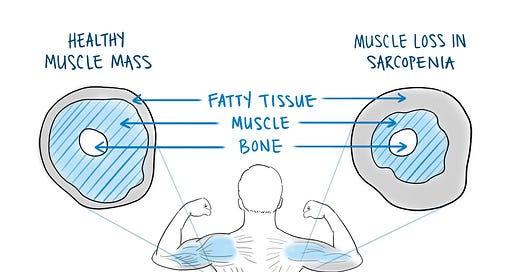As we age, most people expect a few things to decline: energy, speed, maybe endurance. But there’s one silent shift that matters far more than people realize:
We lose muscle and replace it with fat.
And that’s not just a cosmetic issue. It’s a metabolic issue. It’s a health issue, and it’s a longevity issue.
The image above tells the story. On the left, you see a healthy cross-section of a muscle: thick muscle fibers surrounding a strong bone, with minimal fat. On the right? A typical scan from someone with sarcopenia—the age-related loss of muscle mass and function.
More fat. Less contractile tissue.
Same body weight, worse health.
Why This Matters
Muscle isn’t just about strength or appearance. It’s a metabolic organ. A storage depot for glucose. A producer of anti-inflammatory myokines. A buffer against falls, fractures, insulin resistance, and frailty.
As muscle shrinks and fatty infiltration increases, we see rising risks for:
Falls and fractures
Type 2 diabetes
Loss of independence
Longer hospital stays
Higher all-cause mortality
Longer recovery from surgery and more post-surgical complications
When we maintain or increase muscle mass, we see reduced risks and meaningful gains in:
Fewer falls and fractures
Lower risk of type 2 diabetes
Preserved independence
Shorter hospital stays and faster recovery
Lower all-cause mortality
Fortunately, sarcopenia isn’t inevitable. Sarcopenia is preventable—and often partially reversible, with the right interventions.
Here’s what the science (and decades of clinical experience) tells us:
Lift. Something. Regularly.
Resistance training is the most effective intervention for preserving and rebuilding muscle mass (and bone density, too). It’s never too late to start.
Prioritize Protein.
Older adults need more protein, not less.
Stay Active.
Walk. Move.
Push and pull heavy things.
Avoid prolonged stillness. I
Inactivity is the real risk.
Monitor Progress Functionally.
Grip strength, gait speed, and chair rise test are good indicators of health span, much like cholesterol panels.
Muscle is longevity infrastructure.
Power, stability, glucose control, and resilience are wrapped in one biological structure- muscle.
We don’t need to fear aging. But we do need to train for it.
Let’s reframe strength not as a goal for athletes, but as a baseline requirement for aging well.




